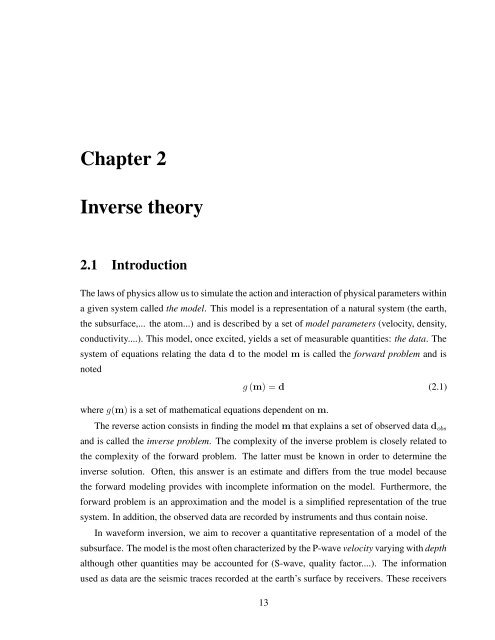Sirgue, Laurent, 2003. Inversion de la forme d'onde dans le ...
Sirgue, Laurent, 2003. Inversion de la forme d'onde dans le ...
Sirgue, Laurent, 2003. Inversion de la forme d'onde dans le ...
You also want an ePaper? Increase the reach of your titles
YUMPU automatically turns print PDFs into web optimized ePapers that Google loves.
Chapter 2<br />
Inverse theory<br />
2.1 Introduction<br />
The <strong>la</strong>ws of physics allow us to simu<strong>la</strong>te the action and interaction of physical parameters within<br />
a given system cal<strong>le</strong>d the mo<strong>de</strong>l. This mo<strong>de</strong>l is a representation of a natural system (the earth,<br />
the subsurface,... the atom...) and is <strong>de</strong>scribed by a set of mo<strong>de</strong>l parameters (velocity, <strong>de</strong>nsity,<br />
conductivity....). This mo<strong>de</strong>l, once excited, yields a set of measurab<strong>le</strong> quantities: the data. The<br />
system of equations re<strong>la</strong>ting the data d to the mo<strong>de</strong>l m is cal<strong>le</strong>d the forward prob<strong>le</strong>m and is<br />
noted<br />
g (m) = d (2.1)<br />
where g(m) is a set of mathematical equations <strong>de</strong>pen<strong>de</strong>nt on m.<br />
The reverse action consists in finding the mo<strong>de</strong>l m that exp<strong>la</strong>ins a set of observed data d obs<br />
and is cal<strong>le</strong>d the inverse prob<strong>le</strong>m. The comp<strong>le</strong>xity of the inverse prob<strong>le</strong>m is closely re<strong>la</strong>ted to<br />
the comp<strong>le</strong>xity of the forward prob<strong>le</strong>m. The <strong>la</strong>tter must be known in or<strong>de</strong>r to <strong>de</strong>termine the<br />
inverse solution. Often, this answer is an estimate and differs from the true mo<strong>de</strong>l because<br />
the forward mo<strong>de</strong>ling provi<strong>de</strong>s with incomp<strong>le</strong>te information on the mo<strong>de</strong>l. Furthermore, the<br />
forward prob<strong>le</strong>m is an approximation and the mo<strong>de</strong>l is a simplified representation of the true<br />
system. In addition, the observed data are recor<strong>de</strong>d by instruments and thus contain noise.<br />
In waveform inversion, we aim to recover a quantitative representation of a mo<strong>de</strong>l of the<br />
subsurface. The mo<strong>de</strong>l is the most often characterized by the P-wave velocity varying with <strong>de</strong>pth<br />
although other quantities may be accounted for (S-wave, quality factor....). The information<br />
used as data are the seismic traces recor<strong>de</strong>d at the earth’s surface by receivers. These receivers<br />
13

















